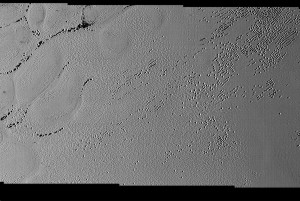THURSDAY, 22 OCTOBER 2015
In a press release last week, NASA released its first color images of Pluto’s dramatic blue atmospheric haze. Soot-like particles called thiolins in Pluto’s upper atmosphere scatter blue light to cause this color. They are formed when ultraviolet sunlight breaks bonds in nitrogen and methane molecules, allowing them to react to form ionic species, which recombine to form larger particles.In a second finding, New Horizons has detected exposed water ice on Pluto. According to Jason Cook of the Southwest Research Institute, “Large expanses of Pluto don’t show exposed water ice because it’s apparently masked by other, more volatile ices across most of the planet. Understanding why water appears exactly where it does, and not in other places, is a challenge that we are digging into.” Surprisingly, the large expanses of water ice appear bright red in color images of the surface, something that the team is still trying to understand.
Those other volatile ices present on the surface leave their mark in other ways. A third released photo revealed a pattern of small pits and troughs. Researchers think this area is composed of volatile ices, such as solid Nitrogen, that exist in equilibrium with the gases in the atmosphere. Pluto’s extremely cold temperatures mean that atmospheric gases do not stay gaseous the whole year round: when Pluto is furthest from the sun, the gases condense and freeze on the surface.
Researchers theorize that these pits and troughs – hundreds of meters across and tens of meters deep – are formed by these ices sequentially evaporating and freezing, and are working to better understand this process and how it causes these pits.
Original NASA press releases:
http://www.nasa.gov/nh/nh-finds-blue-skies-and-water-ice-on-pluto
https://www.nasa.gov/nh/pluto-puzzling-patterns-and-pits
For the latest updates from New Horizons, visit NASA’s New Horizons mission page at https://www.nasa.gov/mission_pages/newhorizons/main/index.html
Written by Hannah Wayment-Steele.

